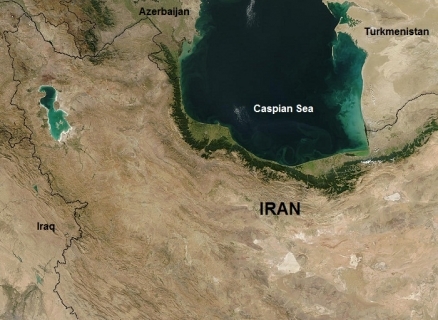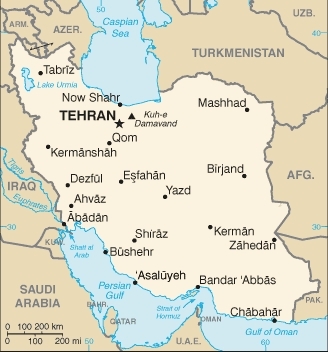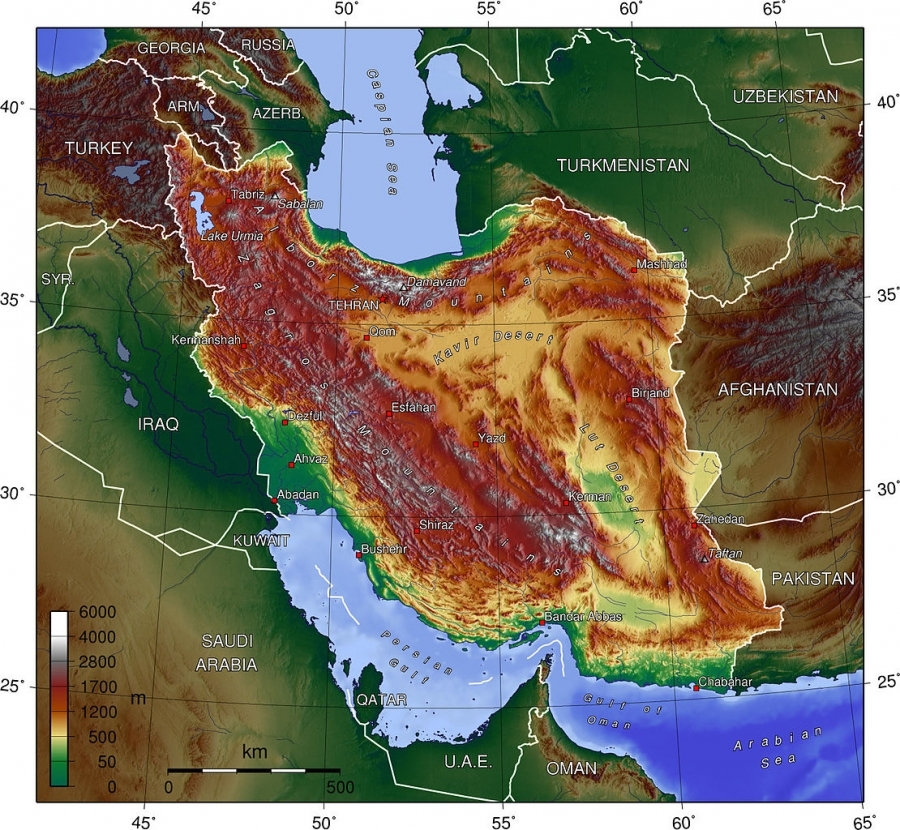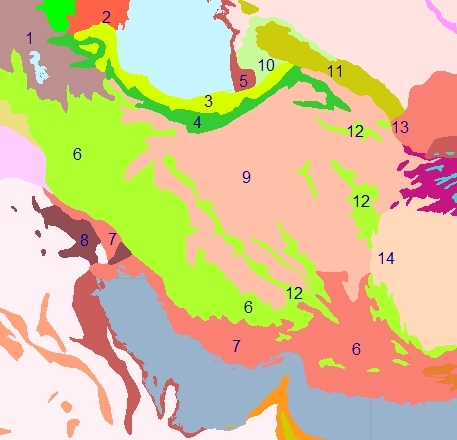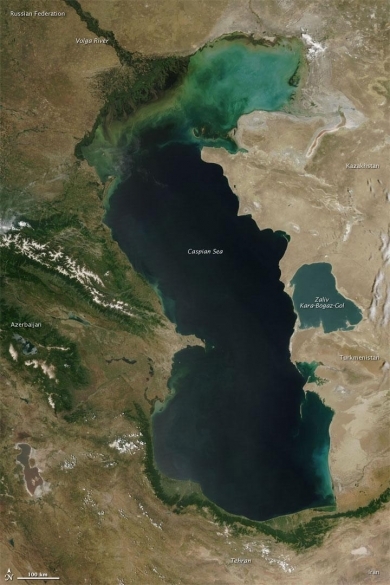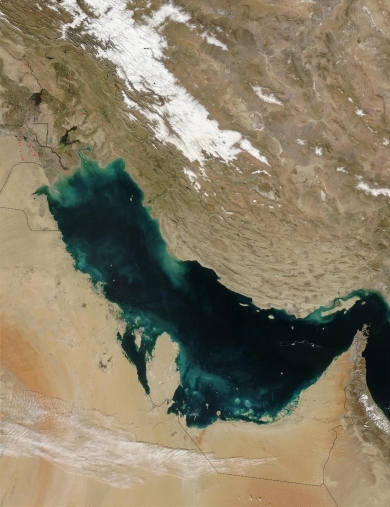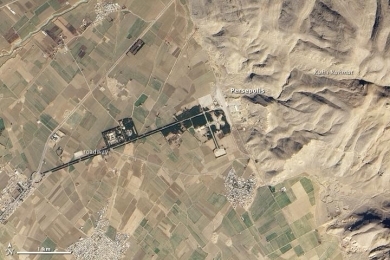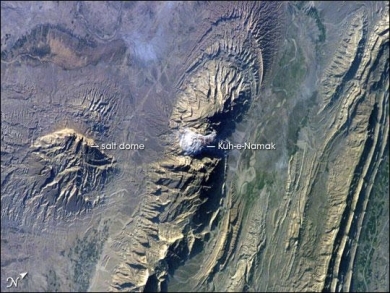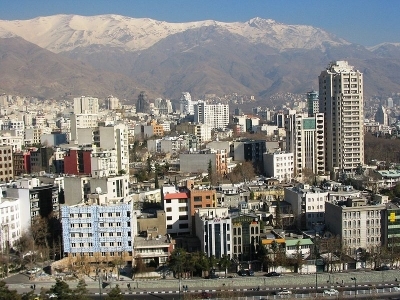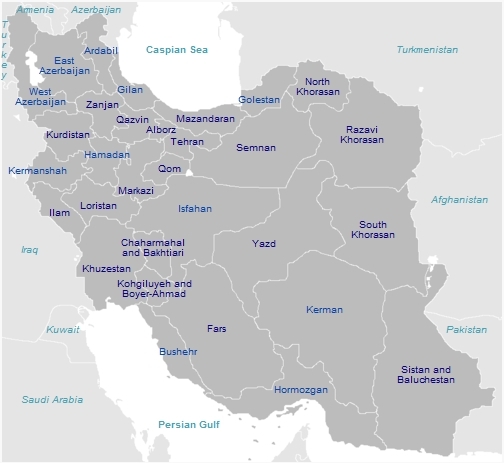Iran (About the EoE)
Contents
Iran
ICountries and Regions of the World Collection  ran is a nation of over 78 million people in the Middle East, bordering the Gulf of Oman, thePersian Gulf, and the Caspian Sea, between Iraq and Pakistan
ran is a nation of over 78 million people in the Middle East, bordering the Gulf of Oman, thePersian Gulf, and the Caspian Sea, between Iraq and Pakistan
Its major environmental issues include:
- air pollution, especially in urban areas, from vehicle emissions, refinery operations, and industrial effluents;
- deforestation;
- overgrazing;
- desertification;
- oil pollution in the Persian Gulf;
- wetland losses from drought;
- soil degradation (salination);
- inadequate supplies of potable water;
- water pollution from raw sewage and industrial waste;
- urbanization
Iran is susceptible to periodic droughts, floods; dust storms, sandstorms; earthquakes.
Known as Persia until 1935, Iran became an Islamic republic in 1979 after the ruling monarchy was overthrown and Shah Mohammad Reza Pahlavi was forced into exile.
Conservative clerical forces established a theocratic system of government with ultimate political authority vested in a learned religious scholar referred to commonly as the Supreme Leader who, according to the constitution, is accountable only to the Assembly of Experts - a popularly elected 86-member body of clerics.
US-Iranian relations have been strained since a group of Iranian students seized the US Embassy in Tehran on 4 November 1979 and held it until 20 January 1981.
During 1980-88, Iran fought a bloody, indecisive war with Iraq that eventually expanded into the Persian Gulf and led to clashes between US Navy and Iranian military forces between 1987 and 1988.
Iran has been designated a state sponsor of terrorism for its activities in Lebanon and elsewhere in the world and remains subject to US, UN, and European Union economic sanctions and export controls because of its continued involvement in terrorism and its nuclear weapons ambitions.
Following the election of reformer Hojjat ol-Eslam Mohammad Khatami as president in 1997 and a reformist Majles (legislature) in 2000, a campaign to foster political reform in response to popular dissatisfaction was initiated. The movement floundered as conservative politicians, through the control of unelected institutions, prevented reform measures from being enacted and increased repressive measures.
Starting with nationwide municipal elections in 2003 and continuing through Majles elections in 2004, conservatives reestablished control over Iran's elected government institutions, which culminated with the August 2005 inauguration of hardliner Mahmud Ahmadi-Nejad as president. His controversial reelection in June 2009 sparked nationwide protests over allegations of electoral fraud.
The UN Security Council has passed a number of resolutions calling for Iran to suspend its uranium enrichment and reprocessing activities and comply with its IAEA obligations and responsibilities. Some of these resolutions subject a number of Iranian individuals and entities involved in Iran's nuclear and ballistic missile programs to sanctions. Additionally, several Iranian entities are subject to US sanctions related to proliferation activities and support of terrorism.
In mid-February 2011, opposition activists conducted the largest antiregime rallies since December 2009, spurred by the success of uprisings in Tunisia and Egypt. Protester turnout probably was at most tens of thousands and security forces were deployed to disperse protesters. Additional protests in March 2011 failed to elicit significant participation largely because of the robust security response, although discontent still smolders.
Iran strategic location on the Persian Gulf and Strait of Hormuz, which are vital maritime pathways for crude oil transport.
Iran protests Afghanistan's limiting flow of dammed Helmand River tributaries during drought.
Geography
Location: Middle East, bordering the Gulf of Oman, the Persian Gulf, and the Caspian Sea, between Iraq and Pakistan
Geographic Coordinates: 32 00 N, 53 00 E
Area: 1,648,195 sq km (land: 1,531,595 sq km water: 116,600 sq km)
Land Boundaries: 5,440 km (Afghanistan 936 km, Armenia 35 km, Azerbaijan-proper 432 km, Azerbaijan-Naxcivan exclave 179 km, Iraq 1,458 km, Pakistan 909 km, Turkey 499 km, Turkmenistan 992 km)
Boundary Disputes:
Iraq's lack of a maritime boundary with Iran prompts jurisdiction disputes beyond the mouth of the Shatt al Arab in the Persian Gulf. Iran and UAE dispute Tunb Islands and Abu Musa Island, which are occupied by Iran.
Azerbaijan, Kazakhstan, and Russia ratified Caspian seabed delimitation treaties based on equidistance, while Iran continues to insist on a one-fifth slice of the lake; Afghan and Iranian commissioners have discussed boundary monument densification and resurvey
Coastline: 2,440 km; note - Iran also borders the Caspian Sea (740 km)
Maritime Claims:
Natural Hazards: periodic droughts, floods; dust storms, sandstorms; earthquakes
Terrain: rugged, mountainous rim; high, central basin with deserts, mountains; small, discontinuous plains along both coasts. The highest point is Kuh-e Damavand (5,671 m) and the lowest point, the Caspian Sea (-28 m).
Climate: mostly arid or semiarid, subtropical along Caspian coast
Topology of Iran. Source: Wikimedia Commons.
Ecology and Biodiversity
|
1. Eastern Anatolian montane steppe 2. Azerbaijan shrub desert and steppe 3. Caspian Hyrcanian mixed forests 5. Central Persian desert basins 6. Zagros Mountains forest steppe 7. South Iran Nubo-Sidanian desert and semi-desert 8. Tigris-Euphrates alluvial salt marsh 9. Central Persian desert basins 10. Kopet Dag semi-desert 11. Kopet Dag woodlands and forest steppe 12. Kuh Rud and Eastern Iran montane woodlands/Kuhrud-Kohbanan Mountains forest steppe 13. Badkhiz-Karabil semi-desert 14. Registan-North Pakistan sandy desert |
See also:
|
Measured by surface area, the Caspian Sea is the world's largest inland water body. It covers roughly 371,000 sq km (143,200 sq mi) and borders five countries. To the ancient Greeks and Persians, the lake's immense size suggested it was an ocean, hence its name. A large expanse of clear sky permitted this natural-color satellite image of the entire water body. The color of the Caspian Sea darkens from north to south, thanks to changes in depth and perhaps sediment and other runoff. The northern part of the lake is just 5 to 6 m (16 to 20 ft) deep. The southern end, however, plunges more than 1,000 m (3,300 ft). Just as the lake reaches a greater depth in the south, the nearby land reaches a greater height. The mountains of northern Iran line the southern end of the giant lake, and emerald green vegetation clings to those mountain slopes. In marked contrast to the mountains, sand seas line the southeastern and northern perimeters of the lake, and marshes occur along the lake shores in Azerbaijan to the west. Multiple rivers empty into the Caspian Sea, the Volga being the largest. Lacking an outlet, the Caspian Sea loses water only by evaporation, leading to the accumulation of salt. Although a lake, the Caspian is not a freshwater lake; the water delivered by the Volga River minimizes the lake's salt content at the northern end, but the Caspian grows more saline to the south. Kara-Bogaz-Gol is a saline inlet along the lake's eastern perimeter. Image courtesy of NASA. |
|
Much of the sediment clouding the water in this image of the Persian Gulf is from the Shatt al Arab River, which enters the Gulf in the north along the Iran-Iraq border. The river drains the combined waters of the Euphrates and Tigris Rivers of Iraq, and the Karun River of Iran. Though other rivers empty into the Persian Gulf, most of its fresh water comes from the Shatt al Arab. On the right edge of the image is the narrow Strait of Hormuz , which connects the Persian Gulf to the Arabian Sea, part of the northern Indian Ocean. The Persian Gulf is flanked to the west by wedge-shaped Kuwait and by Saudi Arabia with its vast tan-, pink-, and white-sand deserts; to the south by Qatar, the United Arab Emirates, and Oman; and to the east by the dry mountains of Iran. The wetlands and rivers of Mesopotamia border the Gulf on the north. The red dots mark gas flares in oil fields of Iran and Iraq. Image courtesy of NASA. |
| In southwestern Iran, roughly 650 km (400 mi) south of the capital city of Tehran, and some 70 km (40 mi) northeast of Shiraz, a cultivated plain gives way to the Zagros Mountains. At the transition between flat land and rugged mountain, at the base of Kuh-i-Rahmat, or "Mountain of Mercy," lies Persepolis. Founded around 518 B.C. by Darius the Great, the site served as the ceremonial capital of the Achaemenid (or Persian) Empire. Image courtesy of NASA. |
| The Zagros Mountains in southwestern Iran present an impressive landscape of long linear ridges and valleys. Formed by collision of the Eurasian and Arabian tectonic plates, the ridges and valleys extend hundreds of kilometers. This astronaut photograph of the southwestern edge of the Zagros mountain belt includes another common feature of the region - a salt dome (Kuh-e-Namak or "mountain of salt" in Farsi). Thick layers of minerals such as halite (table salt) typically accumulate in closed basins during alternating wet and dry climatic conditions. Over geologic time, these layers of salt are buried under younger layers of rock. The pressure from overlying rock layers causes the lower-density salt to flow upwards, bending the overlying rock layers and creating a dome-like structure. Erosion has spectacularly revealed the uplifted tan and brown rock layers surrounding the white Kuh-e-Namak to the northwest and southeast (center of image). Radial drainage patterns indicate another salt dome is located to the southwest (image left center). If the rising plug of salt (called a salt diapir) breaches the surface, it can become a flowing salt glacier. Salt domes are an important target for oil exploration, as the impermeable salt frequently traps petroleum beneath other rock layers. Image courtesy of NASA. |
| Northern Tehran City with Alborz Mountains in the background, Iran. Source: Wikimedia Commons. |
People and Society
Population: 78,868,711 (July 2012 est.)
Ethnic Groups: Persian 61%, Azeri 16%, Kurd 10%, Lur 6%, Baloch 2%, Arab 2%, Turkmen and Turkic tribes 2%, other 1% (2008 est.)
Iran is a pluralistic society. Persians are the largest ethnic group in Iran, though many are actually of mixed ancestry. The population of the country has important Turkic elements (e.g., Azeris) and Arabs predominate in the southwest. In addition, Iran’s population includes Kurds, Balochi, Bakhtyari, Lurs, and other smaller minorities, such as Armenians, Assyrians, Jews, and Brahuis (or Brohi).
Age Structure:
0-14 years: 24.1% (male 9,608,342/female 9,128,427)
15-64 years: 70.9% (male 28,083,193/female 27,170,445)
65 years and over: 5% (male 1,844,967/female 2,055,846) (2011 est.)
Population Growth Rate: 1.247% (2012 est.)
Birthrate: 18.52 births/1,000 population (2012 est.)
Death Rate: 5.94 deaths/1,000 population (July 2012 est.)
Net Migration Rate: -0.11 migrant(s)/1,000 population (2012 est.)
Life Expectancy at Birth: 70.35 years (2012 est.)
Total Fertility Rate: 1.87 children born/woman (2012 est.)
Languages: Persian (official) 53%, Azeri Turkic and Turkic dialects 18%, Kurdish 10%, Gilaki and Mazandarani 7%, Luri 6%, Balochi 2%, Arabic 2%, other 2% (2008 est.)
Literacy (age 15 and over can read and write): 77% (2002 est.)
Urbanization: 71% of total population (2010) growing at an annual rate of change of 1.9% (2010-15 est.)
History
The ancient nation of Iran, historically known as Persia, has traditionally been a major power in the region. Despite invasions by Arabs, Seljuk Turks, and Mongols, Iran has always reasserted its national identity and taken pride in its unique cultural and political heritage.
Archeological findings indicate that human activity in Iran dates back to the middle Paleolithic era, about 100,000 years ago. The sixth millennium B.C. saw the emergence of a fairly sophisticated agricultural society and the rise of proto-urban population centers. Many dynasties have ruled Iran, beginning with the Achaemenid (559-330 B.C.), which was founded by Cyrus the Great. After the conquest of Persia by Alexander the Great ushered in the Hellenistic period (300-250 B.C.), ancient Iran was ruled by the Parthian (250 B.C.-226 A.D.) and the Sassanian (226-651) dynasties.
The seventh-century Arab conquest of Iran, which introduced Islam to the population, was followed by invasions by the Seljuk Turks and the Mongols. Iran experienced a political and cultural revival under the Safavid dynasty (1502-1736), during which Shah Abbas expelled the Uzbeks and Ottomans from Persia. The conqueror Nadir Shah and his Afsharid dynasty (1736-1749) were succeeded by the Zand dynasty (1750-1794), which was founded by Karim Khan, and later the Qajar (1795-1925) and the Pahlavi (1925-1979) dynasties.
Many date the beginning of modern Iranian history to the nationalist uprisings against the Shah in 1905 and the establishment of a limited constitutional monarchy in 1906. The discovery of oil in 1908 would later become a key factor in Iranian history and development.
In 1921, Reza Khan, an Iranian officer of the Persian Cossack Brigade, seized control of the government. In 1925, after finally ousting the Qajar dynasty, he declared himself Shah and established the Pahlavi dynasty.
Reza Shah forcibly enacted policies of modernization and secularization in Iran and reasserted government authority over the country’s tribes and provinces. In 1935, Reza Shah Pahlavi changed the country’s name to Iran to accentuate Persia’s Aryan roots. During World War Two, the Allies feared that the Shah’s close relations with Nazi Germany would jeopardize Iran as a source of oil and a vital supply link to the Soviet Union. In September 1941, following the occupation of western Iran by the Soviet Union and the United Kingdom, Reza Shah was forced to abdicate. His son, Mohammad Reza Pahlavi, ascended to the throne.
After the war, Soviet troops stationed in northwestern Iran refused to withdraw across the border and, instead, supported short-lived, pro-Soviet separatist regimes in the northern provinces of Azerbaijan and Kurdistan. In 1946, under U.S. and United Nations pressure, the Soviets were forced to withdraw their troops. The Shah’s forces then moved in to suppress the Azerbaijani and Kurdish revolts.
In 1951, the government of nationalist Prime Minister Mohammed Mossadegh (alternatively spelled Mossadeq) nationalized the British-owned Anglo-Iranian Oil Company. In the face of strong public support for Mossadegh, the Shah fled to Rome. Although Mossadegh was not a communist, the U.S. and U.K. feared that his links to the communist Tudeh party would cause Iran to align with the Eastern Bloc. Consequently, in August 1953, the U.S. and U.K. supported a coup against the democratically elected Mossadegh, during which pro-Shah army forces arrested the Prime Minister. The Shah returned to Iran soon thereafter and, fearing further opposition, began to govern Iran in an increasingly authoritarian manner.
In 1961, Iran administered a series of economic, social, and administrative reforms--pushed by the Kennedy administration--that became known as the White Revolution. As a result of this program, which was driven by reform, modernization and economic growth proceeded at an unprecedented rate. This tremendous growth was fueled by Iran's vast petroleum reserves, which were then the third-largest in the world. However, while Iran’s economy prospered, democratic reform and civil liberties deteriorated. The Shah’s autocratic method of rule and the abusive practices of SAVAK (his internal security and intelligence service) alienated large sectors of the population, including the Shi’a clergy. The clergy also objected to land reforms that led to the breaking up of their large land holdings.
In 1978, domestic turmoil turned to revolution driven by several disparate groups--nationalists, Islamists, Marxists, and students--who joined together in opposition to the Shah. In January 1979, the Shah fled Iran for Egypt, later traveling to the U.S. to seek medical treatment for cancer; he died in exile in Egypt 1 year later.
On February 1, 1979, exiled religious leader Ayatollah Ruhollah Khomeini returned from France to assume control of the revolution and establish himself as Supreme Leader of a new, theocratic republic guided by Islamic principles.
As Supreme Leader, Khomeini steered Iran’s foreign policy sharply away from its close alignment with the West. In September 1980, during the U.S. hostage crisis, Iraq invaded Iran to prevent the spread of the Islamic Revolution to Iraq’s Shi’a, seize the heavily Arab province of Khuzestan. After 8 punishing years of war, in July 1988 the Islamic Republic of Iran at last agreed to the cease-fire implemented in UN Security Council Resolution 598. Neither nation made any significant territorial gains in the war, although both suffered massive casualties.
Iran's relations with many of its Arab neighbors were strained during the early years of the Islamic Republic because of fears that the Islamic Revolution would spread abroad.
Following Khomeini's death on June 3, 1989, the Assembly of Experts chose the outgoing president of the republic, Ali Khamenei, to succeed him as Supreme Leader, despite Khamenei's relative lack of religious credentials.
In August 1989, Akbar Hashemi-Rafsanjani, Speaker of the Majles, was elected President by an overwhelming majority. He was re-elected June 1993, albeit with a more modest majority. Some Western observers attributed the reduced support for Rafsanjani in 1993 to popular disenchantment with Iran’s deteriorating economy. In August 1997, an overwhelming majority of Iranians elected reformist cleric Mohammad Khatami as President, hoping he would usher in a new era of freedom and reform. Khatami had modest successes in broadening the participation of Iranians in government by holding popular elections for local government councils and encouraging the development of civil society. Although many liberal-minded Iranians were disappointed that Khatami did not support student protesters in 1999, he retained enough popular support to secure re-election in June 2001.
In February 2004, elections were held for the Seventh Majles, in which many reformists were prohibited from running, resulting in a more conservative group of parliamentarians in control of the Majles. In March 2008, the Iranian Government again interfered in parliamentary elections. Although reformist candidates managed to hold onto their positions, the Eighth Majles remained under the control of conservative blocs.
None of the seven presidential candidates on the ballot for the June 17, 2005 elections received a majority, resulting in a two-candidate runoff on June 24 between Tehran mayor (and IRGC veteran) Mahmoud Ahmadi-Nejad and former president Akbar Hashemi Rafsanjani. Some Iranian politicians alleged voter fraud and electoral interference by the IRGC-controlled Basij militia forces during the first round of voting. Ahmadi-Nejad, who won in the second round with nearly 62% of the vote according to Iranian Government figures, assumed office in August 2005. Ahmadi-Nejad was re-elected as Iran's president in June 2009, in a multiparty election that many Iranians considered neither free nor fair. Due to a lack of independent international election monitors, international organizations could not verify the results. Although the final vote tallies remain disputed, the Iranian Government’s official results allocated 62.6% of the vote to Ahmadi-Nejad, with his closest challenger, Mir Hossein Mousavi, receiving 33.8%.
Tehran panorama in winter. (in right part of this panorama photo you can see Milad Tower and Tehran International Tower.) Source: Sasan Geranmehr/Wikimedia Commons
Government
Government Type: theocratic republic
The December 1979 Iranian constitution defines the political, economic, and social order of the Islamic Republic. The document establishes Shi'a Islam of the Twelver (Jaafari) sect as Iran's official religion. Sunni Islam, Zoroastrianism, Judaism, and Christianity are the only other recognized, legal minority religions. The country is governed by secular and religious leaders through governing bodies, whose duties often overlap.
The Supreme Leader holds power for life unless removed by the Assembly of Experts. He has final say on all domestic, foreign, and security policies for Iran, though he establishes and supervises those policies in consultation with other bodies, including the National Security Council and the Expediency Council. The Supreme Leader is the final arbiter on nearly all disputes among the various branches of government, although the Expediency Council is charged with resolving disputes between the Majles and the Council of Guardians. The Supreme Leader appoints officials to key positions including the head of judiciary and the Council of Guardians. He has the power to remove the president and is commander-in-chief of the armed forces.
The constitution stipulates that the Assembly of Experts, which consists of 86 popularly-elected clerics elected to 8-year terms, chooses the Supreme Leader based on jurisprudent qualifications and commitment to the principles of the revolution. The Assembly of Experts reviews his performance periodically and has the power to depose and replace him. Pragmatic conservative candidates generally polled better than their hardline conservative opponents during the December 15, 2006 elections for the Assembly of Experts. Turnout was reportedly 60%, according to unverified Iranian Government statistics. Citizens will not vote for representatives for the Assembly again until 2014.
The Council of Guardians consists of 12 persons. The Supreme Leader appoints the six religious members of the Council, while the Majles selects the six lay members from candidates recommended by the judiciary (which is, in turn, selected by the Supreme Leader). The non-clerics play a role only in determining whether legislation before the Majles conforms to Iran's constitution. The religious members, on the other hand, take part in all deliberations, considering all bills for conformity to Islamic principles. The Council of Guardians can veto any law. This body also certifies the competence of candidates for the presidency, the Assembly of Experts, and the Majles, and it has the power of approbatory supervision over elections.
The president of the Islamic Republic of Iran is elected by universal suffrage to a 4-year term. The president supervises the affairs of the executive branch, appointing and supervising the Council of Ministers (members of the cabinet), coordinating government decisions, and selecting government policies to be placed before the Majles.
The Majles, or National Assembly, consists of 290 members elected to 4-year terms. Elections are held by secret ballot from amongst the candidates approved by the Council of Guardians.
In 1988, Ayatollah Khomeini created the Expediency Council, which resolves legislative issues on which the Majles and the Council of Guardians fail to reach an agreement. Since 1989, it has been used to advise the Supreme Leader on matters of national policy as well. The Expediency Council is composed of the president, the speaker of the Majles, the judiciary chief, the clerical members of the Council of Guardians, and other members appointed by the Supreme Leader for 3-year terms. Cabinet members and Majles committee chairs also serve as temporary members when issues under their jurisdiction are considered. In 2005, it was announced that the Expediency Council, which now has over 40 members, would have supervisory powers over all branches of government, though that has not resulted in any noticeable change in this institution's day-to-day authority or operations.
Judicial authority is constitutionally vested in the Supreme Court and the four-member High Council of the Judiciary; although these are two separate groups, they have overlapping responsibilities and one head. Together, they are responsible for supervising the enforcement of all laws and establishing judicial and legal policies.
Capital: Tehran 7.19 million (2009)
Tehran panorama at night (2006). Generated from 7 shots. Source: Hamed Saber/Wikimedia Commons
Other Major Cities: Mashhad 2.592 million; Esfahan 1.704 million; Karaj 1.531 million; Tabriz 1.459 million (2009)
|
Administrative divisions: 31 provinces (ostanha, singular - ostan); 1. Alborz |
17. Khorasan-e Razavi (Razavi Khorasan) |
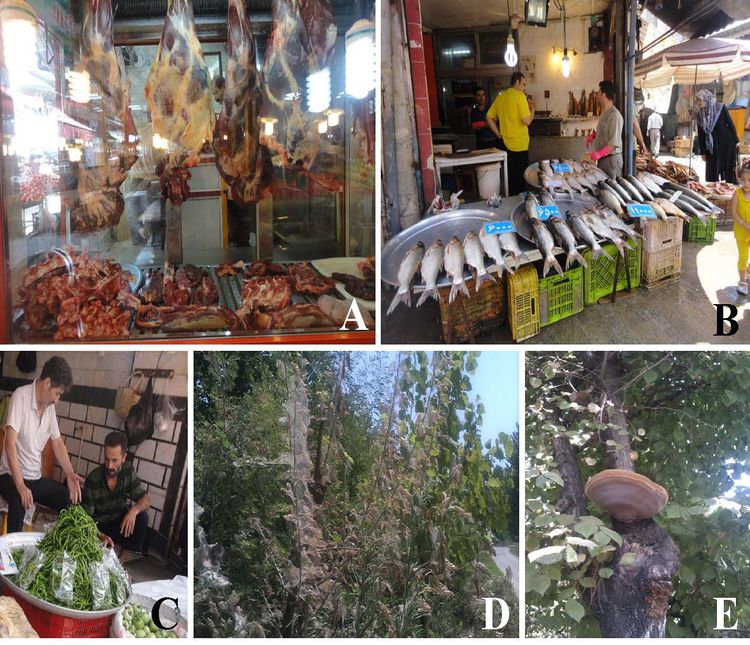 A-C. Glimpses of the capital city of Rasht, Gilan (Guilan) province; D. Vegetation along the Sefidroud river, Pirbazar, Rasht city; and E. Laleh Park, Tehran. Photo credits: Peiman Zandi; Source: Saikat Basu. own work
A-C. Glimpses of the capital city of Rasht, Gilan (Guilan) province; D. Vegetation along the Sefidroud river, Pirbazar, Rasht city; and E. Laleh Park, Tehran. Photo credits: Peiman Zandi; Source: Saikat Basu. own work
Independence Date: 1 April 1979 (Islamic Republic of Iran proclaimed)
Notable earlier dates:
- ca. 625 B.C. (unification of Iran under the Medes);
- ca. A.D. 1501 (Iran reunified under the Safavids);
- 12 December 1925 (modern Iran established under the Pahlavis)
Legal System: religious legal system based on sharia law. Iran has not submitted an International Court of Justice (ICJ) jurisdiction declaration; and is a non-party state to theInternational criminal court (ICCt).
International Environmental Agreements
Iran is party to international agrements on: Biodiversity, Climate Change, Climate Change-Kyoto Protocol, Desertification, Endangered Species, Hazardous Wastes, Marine Dumping, Ozone Layer Protection, Ship Pollution, and Wetlands. Iran has signed, but not ratified international agrements on: Environmental Modification, Law of the Sea, and Marine Life Conservation
Water
Total Renewable Water Resources: 137.5 cu km (1997)
Freshwater Withdrawal: 72.88 cu km/yr (7% domestic, 2% industrial, 91% agricultural)
Per Capita Freshwater Withdrawal: 1,048 cu m/yr (2000)
Agriculture
Agricultural products: wheat, rice, other grains, sugar beets, sugar cane, fruits, nuts, cotton; dairy products, wool; caviar
Irrigated Land: 89,930 sq km (2008)
Resources
Natural Resources: petroleum, natural gas, coal, chromium, copper, iron ore, lead, manganese, zinc, sulfur
Land Use:
Economy
Pre-revolutionary Iran's economic development was rapid. Traditionally an agricultural society, by the 1970s Iran had achieved significant industrialization and economic modernization based on an import-substitution model, largely aided by the growing worldwide demand for oil. However, the pace of growth had slowed dramatically by 1978, just before the Islamic Revolution. Since the fall of the Shah, economic recovery has proven elusive due to a combination of factors, including state interference in the economy and fluctuations in the global energy market. Economic activity was further disrupted by years of domestic political upheaval immediately following the revolution. These conditions were worsened by the war with Iraq and the decline in world oil prices beginning in late 1985. After the Iran-Iraq war, Iran’s economic situation began to improve: GDP grew for 2 consecutive years, partly from an oil windfall in 1990, and there was a substantial increase in imports. Iran's social policies during the Iran-Iraq war additionally resulted in a baby boom, which has left Iran with a large, underemployed youth population today. As a result, Iran suffers from a "brain drain" as its educated youth leave the country to pursue better economic opportunities abroad.
In March 1989, the government instituted a new 5-year plan for economic development, which loosened state control and allowed Iranians greater latitude in accessing foreign capital. However, mismanagement and inefficient bureaucracy, as well as political and ideological infighting, hampered the formulation and execution of a consolidated economic policy, and Iran fell short of the plan's goals. Economic growth was further hindered by a decrease in oil revenues in 1991 and growing external debt. Former president Khatami followed the market reform plans of his predecessor, President Rafsanjani, and indicated that he would pursue diversification of Iran's oil-reliant economy, although he made little progress; high inflation and expansive public transfer programs, as well as powerful economic and political vested interests, posed obstacles for rapid reform during the Khatami era.
Unemployment, a major problem even before the revolution, has continued to plague Iran. However, unemployment statistics only tell part of the story--underemployment continues to affect a large portion of Iran’s young, educated workforce. Although Iran’s poorer, rural population initially enjoyed a psychological boost from the attention given them by the new Islamic government, they are only marginally better off in economic terms. The government has made some progress on rural development, including electrification, road building, and increased access to education, but Iran still suffers from inefficiencies related to agricultural land usage that are politically difficult to reconcile. The agriculture sector still suffers from shortages of capital, raw materials, and equipment--problems that date back to the 1980-1988 Iran-Iraq war.
Today, Iran's economy is struggling as a result of sanctions, a bloated and inefficient state sector, and an overdependence on the oil sector. Although the Supreme Leader issued a decree in July 2006 to privatize 80% of the shares of most government-owned companies, private sector activity is typically limited to small-scale workshops, farming, and the service industry. As a result of inefficiencies in the economy, significant informal market activity flourishes and shortages of goods are common. A combination of price controls and subsidies continues to weigh down the economy, while administrative controls and widespread corruption undermine the potential for private-sector-led growth. Previous government-led efforts at economic reform--such as fuel rationing in July 2007 and the imposition of the value added tax (VAT) in October 2008--were met with stiff resistance and violent protests. In 2010, the Iranian Government passed the Targeted Subsidies Reform, which aims to remove state subsidies on certain commodities and replace them with direct monthly social assistance payments.
Inflation and the unemployment rate continue to be in the double digits. Widespread underemployment amongst Iran’s educated youths has convinced many to seek employment overseas. While Iran’s economic quandary may look grim, Iran has fared worse--notably during the Iran-Iraq war.
Iran's economy is marked by an inefficient state sector, reliance on the oil sector, which provides the majority of government revenues, and statist policies, which create major distortions throughout the system. Private sector activity is typically limited to small-scale workshops, farming, and services.
Price controls, subsidies, and other rigidities weigh down the economy, undermining the potential for private-sector-led growth.
Significant informal market activity flourishes.
The legislature in late 2009 passed President Mahmud Ahmadi-Nejad's bill to reduce subsidies, particularly on food and energy. The bill would phase out subsidies - which benefit Iran's upper and middle classes the most - over three to five years and replace them with cash payments to Iran's lower classes. However, the start of the program was delayed repeatedly throughout 2010 over fears of public reaction to higher prices. This is the most extensive economic reform since the government implemented gasoline rationing in 2007.
The recovery of world oil prices in the last year increased Iran's oil export revenue by at least $10 billion over 2009, easing some of the financial impact of the newest round of international sanctions. Although inflation has fallen substantially since the mid-2000s, Iran continues to suffer from double-digit unemployment and underemployment. Underemployment among Iran's educated youth has convinced many to seek jobs overseas, resulting in a significant "brain drain."
See:
- Energy profile of Iran
- Energy profile of the Caspian Sea region
- Energy profile of the Caucasus region
GDP: (Purchasing Power Parity): $928.9 billion (2011 est.)
GDP: (Official Exchange Rate): $480.3 billion (2011 est.)
GDP- per capita (PPP): $12,200 (2011 est.)
GDP- composition by sector:
agriculture: 11.2%
industry: 40.6%
services: 48.2% (2011 est.)
Industries: petroleum, petrochemicals, fertilizers, caustic soda, textiles, cement and other construction materials, food processing (particularly sugar refining and vegetable oil production), ferrous and non-ferrous metal fabrication, armaments
Currency: Iranian rials (IRR)
Iran's Nuclear Program
Since September 2002, the International Atomic Energy Agency (IAEA) has been working to clarify the nature of Iran’s nuclear program. In one of his most detailed reports to the Board of Governors on Iran’s activities, Director General Mohamed ElBaradei indicated in November 2004 that Iran had failed to report, declare, and provide information on a number of critical issues.
Since November 2004, IAEA Directors General have issued numerous reports on Iran’s implementation of its Nuclear Nonproliferation Treaty (NPT) Safeguards Agreement and relevant provisions of UN Security Council Resolutions 1737, 1747, 1803, and 1929. The IAEA Board found Iran in noncompliance with its Safeguards Agreement in September 2005 and, after Iran restarted uranium enrichment activities at Natanz in January 2006, the Board reported Iran to the UN Security Council (UNSC) for its noncompliance.
In response to the IAEA Board of Governor’s finding of noncompliance, the UNSC has adopted a Presidential Statement (S/PRST/2006, March 2006) and six resolutions (UNSCRs) on Iran: UNSCR 1696 (July 2006), UNSCR 1737 (December 2006), UNSCR 1747 (March 2007), UNSCR 1803 (March 2008), UNSCR 1835 (September 2008), and UNSCR 1929 (2010). Four of the six resolutions (UNSCRs 1737, 1747, 1803, and 1929) impose Chapter VII (legally binding) sanctions on Iran.
In June 2006, China, France, Germany, Russia, the United States, and United Kingdom--the P5+1, also known as the E3+3--offered Iran a substantial incentives package of economic cooperation and assistance in return for Tehran’s full cooperation with the IAEA and suspension of its uranium enrichment-related and reprocessing activities. The P5+1 presented Iran with a refreshed package of incentives in June 2008, but Iran has yet to respond clearly and positively to this offer, or comply with its UNSC and IAEA obligations. On April 8, 2009, the P5+1 invited Iran to meet with the group to resolve international concerns and rebuild the confidence of the international community. On October 1, 2009, the United States and the other P5+1 members met with representatives from Iran in Geneva, Switzerland.
In late 2009, Iran appealed to the IAEA for fuel assemblies for the Tehran research reactor (TRR), which has operated for decades and produces medical isotopes. The IAEA, with support from the United States, France, and Russia, offered a TRR re-fueling proposal that would utilize Iran’s own available low-enriched uranium (LEU) at the Natanz fuel enrichment plant by sending 1,200 kilograms of the LEU to Russia for further enrichment, fabricating it into fuel, and returning it to Iran for use in this safeguarded reactor. The plan would have provided the TRR with much-needed fuel to continue to produce medical isotopes while also beginning to build international confidence in Iran’s peaceful intent by removing the majority of its LEU stockpile from Iran’s territory; however, parties did not reach an agreement on the swap deal.
On June 9, 2010, the UNSC adopted Resolution 1929, the fourth legally binding resolution calling on Iran to halt its proliferation-sensitive nuclear activities and comply with its NPT, UNSC, and IAEA safeguards obligations. The resolution calls for several actions to restore international confidence in the peaceful nature of Iran’s nuclear program.
International concerns regarding the nature of Iran’s nuclear program were deepened and reaffirmed by a November 2011 IAEA Director General’s report that concluded that Iran has carried out activities “relevant to the development of a nuclear explosive device," and “that prior to the end of 2003, these activities took place under a structured program, and that some activities may still be ongoing." On November 18, 2011, the IAEA Board of Governors passed a resolution expressing its deep concern about the unresolved issues regarding Iran’s nuclear program and calling on Iran “to engage seriously and without preconditions in talks aimed at restoring international confidence in the exclusively peaceful nature of Iran’s nuclear program.”
